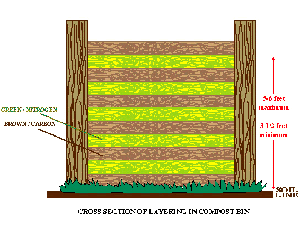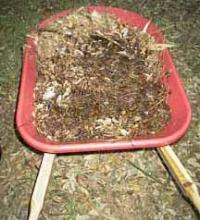
BUILD A PILE
Microbes are not much different than people in terms of their basic needs, so be sure to provide your microbes with all of the basics:
| Food | Browns (carbon-rich) and greens (nitrogen-rich) |
| Water | Moist, not soggy |
| Air | Oxygen |
| Volume | Cube: 3 feet long x 3 feet high x 3 feet deep Cylinder: 3 feet high x 3–5 feet diameter |
| Particle size | Less than 2–3 inches |
Sandwich Method
Layer compost materials/ingredients into the composting system using a balance of green and brown materials. Over time, you will develop a unique "recipe" for your composting system.
Compost bin layering
Generally speaking,
- Alternate layers of green (high nitrogen) and brown (high carbon) materials. Thin layers help prevent anaerobic pockets from developing to cut down on odors;
allows microbes access to green and brown food sources - Water each layer as you build it so material is moist not wet, like a wrung sponge. Moist, not wet, material promotes even distribution of water through the pile.
- Finish with a brown layer. A brown layer on top of the pile will help filter odors, if any, emanating from the system.
Mix-It! Method
If you are using a "no-turn" method, or if you want to speed up the composting process, try the Mix It! Method. Simply mix up the green and brown materials before adding them to the compost system. This prevents the moist greens (grass clippings, for example) from forming compact layers that may restrict the flow of water and oxygen through the pile.
Add the mixture to the compost system in 4"-deep batches. Water each batch so that the moisture is evenly distributed. It's really difficult to get water into the whole pile after the pile has been built, so add water as you build the pile.
Mix materials in a wheelbarrow and then put them in the compost bin.
Adding More
You can add fresh materials to an actively (or passively) composting pile. One way to add materials to an existing pile is to add them as you mix or turn the pile. Burying new materials in the pile also works well. Eventually, you will want to start a second batch of compost for adding fresh materials. This will give the first batch of compost time to stabilize and mature.
The materials you add will supplement the existing food base. If you add more greens, the effect will be adding nitrogen and potentially speeding up the composting process, increasing moisture, and/or heating up the pile. If you add more browns, the effect will be increasing carbon, and potentially slowing the composting process, drying out the pile, and/or reducing pile temperature.
Learn More
- Natural Resources



